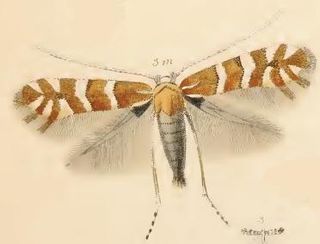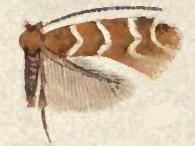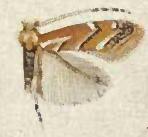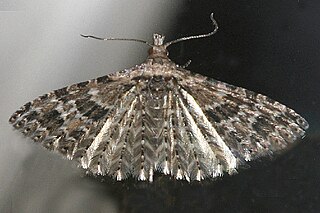
Honeysuckles are arching shrubs or twining vines in the genus Lonicera of the family Caprifoliaceae. It includes 158 species native to northern latitudes in North America, Eurasia, and North Africa. Widely known species include Lonicera periclymenum, Lonicera japonica and Lonicera sempervirens. L. japonica is a highly invasive species considered a significant pest in parts of North America, Europe, South America, Australia, and Africa.

Hemaris diffinis, the snowberry clearwing, is a moth of the family Sphingidae. This moth is sometimes called "hummingbird moth" or "flying lobster". This moth should not be confused with the hummingbird hawk-moth of Europe.

Phyllonorycter trifasciella is a moth of the family Gracillariidae. It is found in Western Europe.

Athrips mouffetella is a moth of the family Gelechiidae. It is found from central and northern Europe to the Ural Mountains, Siberia and the Russian Far East. It has also been recorded from North America.

Phyllonorycter emberizaepenella is a moth of the family Gracillariidae. It is found in all of Europe, except the Iberian Peninsula and the Balkan Peninsula.

Phyllonorycter symphoricarpaeella is a moth of the family Gracillariidae. It is known from Kentucky, Ohio, Texas, California and Maine in the United States.

Phyllonorycter mariaeella is a moth of the family Gracillariidae. It is known from Canada and the United States.
Phyllonorycter oregonensis is a moth of the family Gracillariidae. It is known from Oregon, United States.

Phyllonorycter fragilella is a moth of the family Gracillariidae. It is known from Québec in Canada and Texas, Maine, Michigan, New York, Massachusetts, Illinois and Wyoming in the United States.

Cameraria gaultheriella is a moth of the family Gracillariidae. It is known from British Columbia, Canada, and California, Oregon and Maine in the United States. It is an adventive species in the Netherlands and the United Kingdom, but is not established.

Cameraria saccharella is a moth of the family Gracillariidae. It is known from Ontario and Quebec in Canada, and Illinois, New Jersey, Ohio, Maine, New York, Connecticut and Vermont in the United States.

Cameraria fletcherella is a moth of the family Gracillariidae. It is known from Québec and Ontario in Canada and Illinois and Maine in the United States.

Cameraria betulivora is a moth of the family Gracillariidae. It is known from Ontario and Quebec in Canada and the United States.

Cameraria bethunella is a moth of the family Gracillariidae. It is known from Ontario and Quebec in Canada, and Illinois, Kentucky, Connecticut, Maine, New York and Texas in the United States.

Cameraria hamameliella is a moth of the family Gracillariidae. It is known from Ontario, Québec, and Nova Scotia in Canada and throughout the eastern United States.
Phyllonorycter raikhonae is a moth of the family Gracillariidae. It is known from Tajikistan.

Perittia herrichiella is a moth of the family Elachistidae. It is found from Sweden and Finland to the Pyrenees and Italy and from France to the Baltic region and Romania. It has also been recorded from Russia and North America, including New York, Ontario, Indiana and Michigan. The expected range of the species is south-eastern Canada and the north-central and north-eastern parts of the United States.

Perittia obscurepunctella is a moth of the family Elachistidae found in Europe.

Alucita montana, the Montana six-plume moth, is a moth of the family Alucitidae. It was described by William Barnes and Arthur Ward Lindsey in 1921. It is found in North America from south-western Quebec and Vermont, west to British Columbia and south to Arizona, California and Texas.

Hemaris aethra, the Diervilla clearwing, is a moth in the family Sphingidae. It is native to the northern United States and southern Canada. Like H. diffinis, with which it shares some of its range, H. aethra is a bumblebee mimic.








